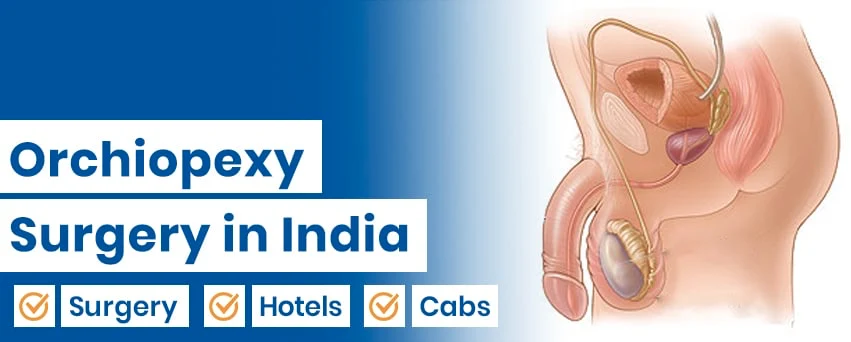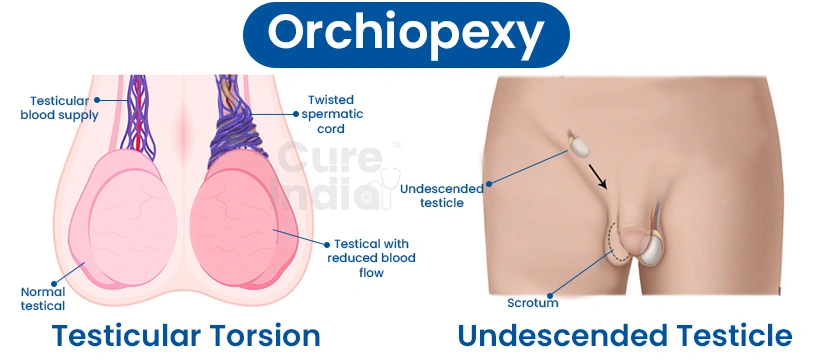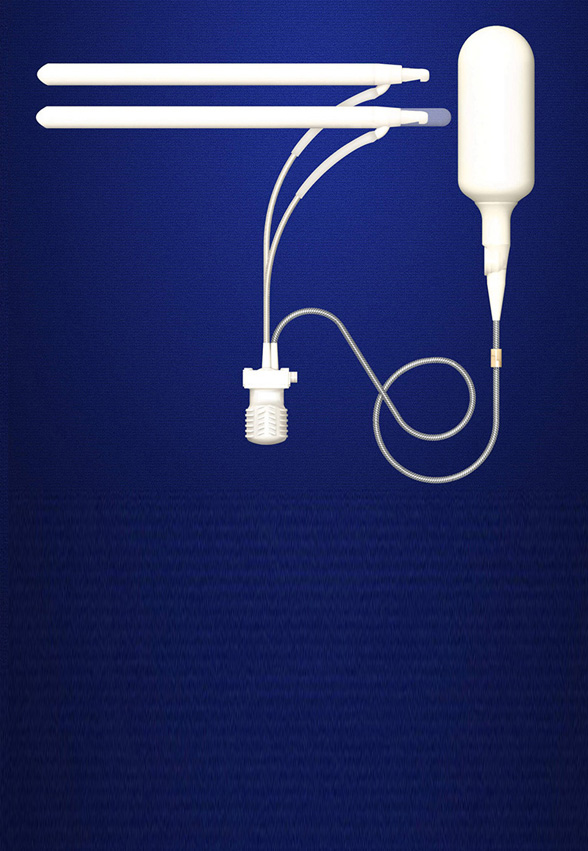

Orchiopexy is a surgery that is performed to correct an undescended testicle or to prevent a testicle from moving back into the groin. During the procedure, a surgeon carefully relocates the testicle into the scrotum and secures it in place. Depending on the testicle’s position, the surgery is either performed through the abdomen or the groin. Orchiopexy is a safe and commonly performed procedure that helps reduce the risk of future complications such as infertility, testicular cancer, and testicular torsion.
Many African patients opt for orchiopexy surgery in India due to the country's high-quality healthcare services at affordable costs. Indian hospitals for orchiopexy surgery offer advanced pediatric and adult urology care, experienced surgeons, modern surgical techniques, and shorter waiting times. Along with that, international patient support, English-speaking medical staff, and well-equipped hospitals make India an accessible country for African patients needing safe and effective orchiopexy treatment.
Orchiopexy is a surgical procedure during which the surgeon moves a testicle from the groin to the scrotum. Surgeons fix the testicle to the scrotum. An orchiopexy can correct and prevent the recurrence of testicular torsion. Other terms for an orchiopexy include an undescended testicle repair surgery or an open orchidopexy.
Testicular torsion and undescended testicle surgery are two distinct urological problems. An orchiopexy is intended to correct these issues. Surgeons perform this under general or epidural anesthesia.
Prompt action is crucial to prevent tissue death in cases of testicular torsion. It is also essential to avoid testicle excision. The disease develops when the testicle rotates, twisting the spermatic cord that supports it. This twisting action cuts off the testicle's blood supply. "Bell clapper deformity" is a congenital abnormality responsible for 90% of torsions. This is the condition in which the testis floats freely instead of adhering to the scrotal lining.
An orchiopexy involves the surgeon manually untwisting the spermatic cord. This is done through an incision made in the patient's scrotum. Next, the testicle is inspected to look for signs of tissue death. Surgeons might remove the entire testicle (orchiectomy) if there is any necrosis. The testicle will be sutured to the scrotal wall if the tissue is in good condition. To avoid torsion, the surgeon may operate on the unaffected testicle in some situations. This is especially the case when both testes are detached from the scrotal lining.
Another issue that can necessitate an orchiopexy is undescended testicles. The testicles develop in the abdomen during fetal development. They descend into the scrotal sack just before birth. One or both testicles do not fall to their permanent residence in the scrotum in about 34% of newborns. The testicle can get stuck in the abdominal cavity or the inguinal (groin) canal.
Nevertheless, during the first year of life, the testicle(s) will shift spontaneously. This occurs in more than 50% of those cases into the scrotum. By then, if the testicle(s) have not moved, an orchiopexy will be necessary to lower the chance of:
A urologist may choose diagnostic laparoscopy to pinpoint the location of the testicle. During this, surgeons make an abdominal incision. They insert a tube with a light source, and a camera at its tip. This is done to ascertain the surgical approach, which may involve the abdomen or the groin.
The surgeon will make a small incision in the groin and scrotum if the testicle(s) are found there. After being removed from the groin, the testicle is inserted into the scrotum. It is then secured there with sutures, which the body will gradually dissolve.
Orchiopexy is most commonly performed in infancy or early childhood for undescended testicles. Medical guidelines recommend that the surgery be done between 6 and 18 months of age, ideally before the child turns one year old. Early correction of these condition help reduce the risk of infertility, testicular cancer, and other complications later in life.
Orchiopexy may also be performed in adolescents or adults if an undescended or retractile testicle is diagnosed later. There is no fixed upper age limit; surgery can be done whenever the condition is identified.
In cases of testicular torsion, orchiopexy is an emergency procedure. Immediate surgery is required to restore blood flow and save the testicle. If blood flow is not restored within a few hours, removal of the testicle can become necessary.
Orchiopexy for undescended testicle treatment is a sensitive procedure that requires a skilled paediatric urologist or urologist with deep experience in genital and paediatric surgeries. India offers a wide network of such specialists, many working out of major super-speciality hospitals. Choosing a surgeon with proven expertise in orchiopexy can help increase surgery outcomes, recovery, and well-being. Here is a list of our top orchiopexy surgeons in India:
Dr. Gautam Banga is an orchiopexy specialist urological surgeon with over 20 years of expertise in orchiopexy and related reconstructive and pediatric urology procedures. With years of experience in managing undescended testis, testicular torsion, and other genitourinary anomalies, Dr. Banga is adept at performing both traditional and minimally invasive surgical techniques.

Dr. Raman Tanwar is among the leading urologists in India who is noted for his proficiency in performing orchiopexy, circumcision, reconstructive urology, and related surgeries. His extensive experience and international training have made him a big name for families seeking correction of undescended testicles and repair following testicular torsion.

Dr. Sanjay Gogoi brings over 25 years of experience as a urology specialist and is recognised among the top specialists in India for performing orchiopexy and related pediatric urology surgeries. His extensive surgical practice covers undescended testes, testicular torsion repairs, and corrective genital surgeries in infants, children, and adults.

Dr. Rajiv Yadav is a top-rated urologist in India whose areas of specialisation include orchiopexy and other genitourinary surgeries. He is known for his comprehensive treatments, especially for conditions like undescended testis and testicular torsion. He ensures surgical competence with sensitivity to patient and family, explaining treatment options clearly and guiding them through the whole recovery process.

A variety of benefits come with an orchiopexy surgery, such as:

Orchiopexy can help preserve fertility by allowing the testicle to develop normally in the scrotum. Studies also show that early orchiopexy helps reduce the risk of testicular cancer and makes future cancer detection easier.
If the testicle is injured in your groin rather than your scrotum, you have a higher chance of damaging it. Sports, tight clothing, belts, and seat belts over the lap increase the risk of injury.
If your child grows older and has one or no testicles in their scrotum, they might become humiliated. Most patients are happy with their orchiopexy outcomes and feel better about their bodies.
The danger of problems or adverse consequences is low with an orchiopexy. This makes it a generally safe treatment. The majority of folks get to go home the same day after the procedure.

You will consult with your healthcare practitioner before an orchiopexy. Before going for an orchiopexy surgery, the doctors will assess your or your child's overall health. Vital signs (blood pressure, pulse, and temperature) will also be taken.
You need to share any medications, including herbal supplements, that you or your kid are taking. This information is crucial to share with your healthcare professional. Anti-inflammatory drugs and other herbal supplements can make bleeding more likely.
Your healthcare professional will receive precise instructions before the surgery. This is regarding when to feed your youngster before the surgery. Most patients should abstain from eating or drinking anything after midnight the night before their Orchiopexy. Take a tiny sip of water with any prescription drugs you must take.
The day before and the morning of the surgery, wash your groin area well to lower the chance of infection. Orchiopexy in adults may also be caused sometimes in rare cases.
If an orchiopexy is for testicular torsion or an undescended testicle surgery, recovery will vary. The duration and specifics of the recovery process depend on the individual case and the nature of the surgery. If the treatment addresses an undescended testicle, the patient can usually return home the same day.
He might have to spend a few days in the hospital. This is true in case the testicle was positioned high in the abdomen or inguinal canal. Otherwise, doctors typically prescribe painkillers to treat the pain and antibiotics to stop infections.
After an orchiopexy, the patient should refrain from biking, athletics, and other activities. This precaution is necessary to avoid any potential injury to their genitalia. It should be followed for two to three weeks after the orchiopexy procedure. The patient will be advised to relax for a few days. This recommendation follows an outpatient orchiopexy for testicular torsion.
During orchiopexy surgery, it's necessary to drink water and elevate the scrotum on a pillow. This is to lessen discomfort and swelling. Avoid engaging in any activity that could result in genital harm.
The cost of Orchiopexy in India is around $2,500, depending on factors like the hospital, type of surgery (open vs laparoscopic), and related care. This cost is very affordable when compared with countries like the US and the UK. The average cost of orchiopexy surgery in India along with the total stay is mentioned below:
| Treatment Name | Cost in India | Stay in India |
|---|---|---|
| Orchiopexy Surgery in India | $2,500 | 7 Days |


Suffering from Erectile Dysfunction
Open up and get treated
Semi Rigid and Inflatable Penile Implants
Get back the Erection
Insecure about your size
Get Penile Augmentation